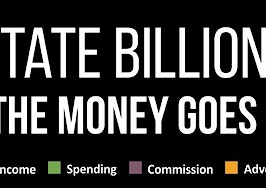Long-term rates have stabilized — maybe a bit better than that. The 10-year T-note today breaking below 2.31 percent resistance, but mortgages are still above 4 percent.
Rates have jumped a half-percent in 60 days and were due for a breather, but all should expect outsize volatility ahead — true upping and downing.
Since 2007, any discussion of “uncertainty” causing volatility described pathways back into the pit. Now the future is more uncertain, but it’s not a bad-news deal. The pit risk is lower, but the good-news potential is far higher. On net, greater volatility.
Interest rates are driven by the bond market. That’s what it does. To those who play on that freeway, it doesn’t matter if they get hit by a rattletrap pickup or a brand-new Lexus. Hit is hit. That’s why interest rate commentary so often seems grim, even when the economic tilt is to the better.
Here is the uncertainty list as of today. A collection of double-headers.
Greece. Rates are better today in largest part because of safety plays before the weekend. Nobody wants to be exposed to news when markets are closed. Although the tilt is to fear Grexit and cover up, nobody has any idea what will follow if it happens. Greece could fall apart into failed-nation status, real privation and insurrection — or, escaping the euro and debt, thrive on the drachma. We don’t even know which of those two poles is the greater risk to markets and euro-idiocy.
Greece II. The one general agreement: Everyone outside of Europe is sick of the subject. With the exception of Czar Vladimir, who could not be more pleased by the daily parade of European self-deception and decadence.
The Fed. I believe in the Fed, and I like and trust Chair Janet Yellen. However, I would like this Fed interval to conclude, and bet she would even more than me.
This period of “hold us back” is stupid. The Fed is trying to give us guidance, and avoid overlarge surprise, but the lesson of the last several years is painful: The Fed’s forecasting is broken. Far better just to shut up. Stick with Greenspan-style fog projection until it’s time to do something and everyone else knows. Children should never hear parents’ confessions to each other that they don’t know what they’re doing.
The Fed II. The unemployment rate and its proxies (new claims for unemployment insurance) have reached levels previously guaranteed to produce rising wages and inflation. An Okieism applies: not neither. The Fed is borderline desperate to get one rate hike done. But nobody knows what its impact will be, let alone the one after it. Market panic? Nothing? Either do it or shut up.
Bubbles. At the top of course: the Fed’s zero percent and quantitative easing will create bubbles. See above: Nobody knows.
Second: stocks. Please pay no attention to stocks. Nobody knows how to predict their future, and their future does not predict the economy. The rare busts and bubbles have some external effect, but more like weather to be endured or enjoyed, not a mechanism.
Third candidate: housing. Ever have a cat who got lucky at the bird feeder? No more seed, no birds, but that cat will watch the feeder.
Bubbles II. In the annals of bubbleology, you won’t find one without credit gas. No credit, no helium, and balloons can’t even lift their own strings off the ground. My friend, Paul Kasriel, retired chief economist at Northern Trust, has watched the Fed’s H.8 “total bank credit” in the last few years and found a predictive model for the economy. In the first four months of 2015, bank credit grew at an 8.2 percent annual pace, predictive of the rebound we are enjoying now. Since April … 2.6 percent annualized.
The only significant credit growth: student loans and cars. Those are bubbles. Colleges are ruinously unaffordable, and everyone already has a new car.
Mortgages? The Fed’s best data: Z.1, every 90 days the “Financial Accounts of the U.S.” In the mortgage category, all types, growth in the last year: zero.
Oh, there is some net-new, as the total includes more write-downs of old garbage, HELOC subprimes (since the 2006 peak, 45 percent and 70 percent written off, respectively).
For econo-junkies, all of this uncertainty helps to kill the six weeks until football.

The chart above shows the 10-year T-note back to Jan. 1, 2007. The bottom of the Great Recession seems clear in 2012 (three years after formal conclusion). Then in mid-2013 the “taper tantrum,” as the Fed began to pull back from the emergency.
The chart is weak — I don’t see anything to stop a run back to that nifty double-top at 3 percent, winter 2013-2014 (mortgages pushing 5 percent), except of course an economic swoon.

The 2-year T-note is the Fed predictor. It began to build in a rate hike or two in 2014, after the tantrum. But in the last six months traders have shown total disbelief in the Fed’s forecasts of tightening.

The Damned Little Dots following this week’s Fed meeting: 17 votes cast by Fed governors (five appointed by the president and confirmed by Congress, all following Yellen), and the 12 regional Fed presidents (half of whom are very competent, half propeller-heads).
Automatically throw out the highest six dots, voters who have been wrong about the economy and inflation for eight straight years. Also toss the lowest (the Minneapolis Fed president has lost his marble on the dovish side).
That leaves a 2015 grouping insisting that it will tighten twice this year, a 2016 cluster insistent on four more quarter-point hikes in 2016, and four more in 2017. Do I believe that? Does anybody?

Nobody believes the damned dots. This chart back-walks the dots, showing that every 90 days the Fed has had to push them forward, the forecast wildly too aggressive. And the red line: “OIS” is the option traded in markets, real money going down to bet on the Fed’s future course. NOBODY believes. It is foolish and dangerous of the Fed to publish continuously mistaken forecasts of its own action. Worse than meaningless: misleading.

This chart is on the mind of every economy-watcher. Both productivity and population are near zero growth. How to get growth going, let alone inflation or a bubble?

Mortgage equity withdrawal still shows a 2 percent annual subtraction from disposable income, the continuing triumph of write-offs over new supply. Supply is short because banks hate to hold mortgages (for good reason), and Fannie-Freddie-FHA are in irons.
Lou Barnes is a mortgage broker based in Boulder, Colorado. He can be reached at lbarnes@pmglending.com.








